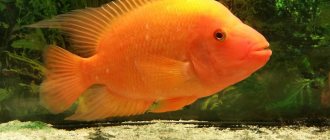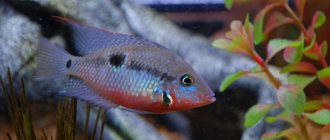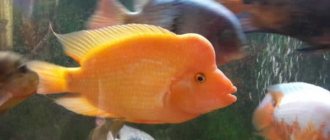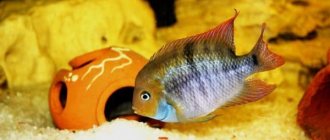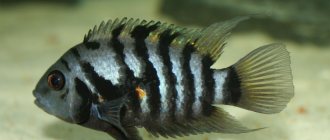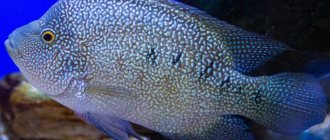Managuana cichlasoma Parachromis managuensis (formerly Cichlasoma managuense) or jaguar cichlid is a large, predatory, but very beautiful fish that is suitable for cichlid lovers. Unlike other cichlids, the Managuan cichlid only turns its brightest color when it is fully mature. For example, juveniles have noticeable dark stripes on their bodies, while adult fish already become spotted, which is why they are nicknamed jaguars.
Description
Parachromis managuensis, formerly cichlasoma managuense, belongs to the family Cichlidae, a species of cichlid. The fish got its name "Managua" because of its habitat - Lake Managua. Later, it was found to inhabit many freshwater lakes in Central America.
In America, this fish is commercial, that is, it is caught and used for food. And in Europe and Asia, the jaguar is considered exclusively an aquarium fish.
Due to its wide distribution, the pet is adapted to different natural conditions; it feels good in overgrown lakes and rivers with fast currents and without vegetation. This makes it easier to keep jaguars in an aquarium; there is no need to create special conditions for them. But in general, the cichlid feels better in water with a high temperature, gentle current and not too much oxygen in the water.
The jaguar fish is described as one of the largest among the Cichlids. Therefore, it is rarely kept in home aquariums due to the tank being too large. Typically, cichlids are purchased for offices, restaurants, cafes and other establishments.
Appearance
Cichlids grow in natural conditions up to 60 cm. The body length of fish bred in captivity is shorter - female representatives grow up to 35 cm, and male representatives up to 40. But even such reduced sizes cause difficulties in maintenance due to their large size.
The body is elongated and strongly flattened on the sides. The wide body tapers towards the head and tail. The head has the shape of a triangle with the muzzle slightly raised upward. The lower jaws are massive and protrude above the upper jaws. The mouth is small, but large lips make it appear larger. Due to the movable attachment of the jaws, the fish is able to swallow large prey. The eyes are usually brown-amber.
The dorsal fin starts out small, but then gradually unfolds and increases in length. At the end, the fin resembles a sail. The anal fin is almost exactly the same as the dorsal fin. The ventral fin is small in size. The lateral fins are usually a transparent beige color, while the rest are the same spotted color as the body. The ends of the fins are sharp and barbed for self-defense.
The color of cichlazoma depends on age:
- In childhood, there are no characteristic spots on the body; the fry are pale in color, often with horizontal dark stripes.
- Around the age of a couple of months, the color changes. The stripes are gradually replaced by spots, the number of which only increases with age.
- Adult representatives often have a horizontal dark stripe in the middle of the sides, made up of large spots.
Diamond cichlazoma
The fry grow unevenly. Relative stability can be achieved by using the smallest starter feed - “live dust”, just hatched from the ephippia of cladocerans (daphnia). Later, you can move on to larger foods - nauplii of Artemia salina and juvenile moin. Large sizes of the nursery aquarium and regular hygiene measures with a complete change of water with fresh water are mandatory.
The use of medications is justified after an accurate diagnosis of the disease has been established due to the different sensitivity of bacteria to certain drugs. Treatment involves mandatory transplantation of affected fish into a separate, medium-sized quarantine pond. If qualified diagnosis is difficult, it is best to place the diseased fish, together with its neighbors from the same aquarium, for 1-2 weeks in a small (20-60 l) vessel with powerful aeration, which contains 5-6 medium-sized clawed frogs.
For the development of young cichlases and their preparation for full spawning, the correct choice of food is of great importance. The fry grow quickly even on monotonous dust-like live food: it is preferable to feed adolescents and fertile adults with large bloodworms, coretra, daphnia (magna and pulex), and occasionally and not very abundantly with tubifex. Digestive problems in cichlases are quite rare due to the high concentration of hydrochloric acid in the gastric juice, and if they do occur, the fish usually overcome them on their own, especially during a 5-7-day fast.
Content
The difficulties in keeping a jaguar are related to its size. It is difficult to find a sufficiently spacious aquarium, especially when keeping several representatives of the species.
Another difficulty lies in its aggressive nature and territoriality. Such fish have no neighbors at all or are very carefully selected. To keep them safe in the aquarium, you need to make a lot of shelters.
Fish quickly pollute the water, so 1/3 of the aquarium volume needs to be replaced weekly.
Aquarium
The volume of the aquarium for one fish is at least 60 liters, optimally 80 liters. For a couple or group you will need an aquarium larger than 100–200. And if you keep them with other large fish, then the volume of the aquarium should be 500 liters.
It is not recommended to purchase aquariums of unusual shapes. The usual rectangular tanks are suitable. For safety, a lid is required, although cichlids rarely try to jump out.
Water parameters
| Parameter | Meaning |
| Water temperature | 24–28 degrees. Withstands temperatures from 22 to 32 degrees. |
| Water acidity | 7.0–8.7 ph |
| Hardness of water | 10–15 dGH |
Plants
These pets are incompatible with vegetation. Even without intention, they will accidentally break off all the leaves and branches. Only artificial plants are allowed, but they must not have sharp edges.
To keep the fish calm, you can place floating plants (riccia, duckweed) or dry oak leaves in the aquarium to create shade.
Priming
Fish love to dig up the soil, so heavy particles without sharp edges are suitable as a substrate: pebbles, gravel.
Equipment
The aquarium must be equipped with an aeration and filtration system. Jaguar cichlases have a reputation for being messy, so they quickly clog up your aquarium. To purify water you will need a powerful filter and compressor.
Lighting
In nature, fish prefer dark places, so there are no bright light sources in the aquarium. During the day, normal lighting is sufficient, and in the evening, low backlighting is sufficient.
Breeding
Managuan cichlasoma is bred without problems and most often the difficulty is in selecting a pair. In order to successfully select it, it is necessary to raise a small flock of 5-8 fry and they themselves form the necessary pairs. Buying already adult fish from separate aquariums rarely ends in success.
To stimulate it, it is important to start feeding the couple intensively, do water changes up to twice a week and raise the temperature to 27-28 degrees.
The couple makes good parents. The male guards the offspring, and the female monitors the eggs so that there is no debris and snails.
On the third day, the yolk sac resolves and the fry can begin to be fed with rotifers or Artemia nauplii.
Feeding
Live food is best eaten. It includes:
- live fish;
- shrimp meat;
- earthworms.
Sometimes they feed it with frozen bloodworms or pieces of beef heart. They also eat dry food and flakes, but with less appetite. The particles in such food must be large, otherwise the fish simply will not notice them.
Cichlids are fed twice a day, with a break of at least 10 hours.
Cichlazoma severum
Managuana cichlid (Parachromis managuensis). The Managuana cichlid is a powerful, bright fish, named after its habitat.
It can only be kept in very large aquariums, since this fish is large, growing up to 30-40 cm. For a pair of adult fish, a volume of 400 liters is needed, and if it is a common aquarium, then 600-800 liters or more.
In a community aquarium, Managuans can be kept with large cichlids, arowanas, polypteruses, and stingrays. Jaguars (another name due to their coloring) are calm, not fussy fish, one might even say important; they are not the first to attack, but staunchly guard the chosen territory. Especially before spawning. This is if they live with large fish. Managuans cannot be planted with small fish; they will be eaten on the very first day, maintaining all the same importance.
The Managua cichlid is an active predator that feeds not only on small fish, but also on large bloodworms, earthworms, large insect larvae, and dry food (large granules).
Given the excellent appetite of these fish, you should install a powerful filter in the aquarium and change up to 40% of the water volume weekly. Good aeration is also required.
The aquarium with these fish is decorated with stones and driftwood, which must be firmly secured, since jaguars dig the soil. It is better to put the soil from small pebbles. Live plants with Managuan cichlids do not survive.
The water temperature for keeping these cichlids is 24 – 27℃, the desired hardness is 15 – 25°, pH 7 – 8.
Managuans reach sexual maturity by the age of one year, having a size of approximately 20 cm. They reach their maximum size by three years. Males are much larger than females, brighter in color (there are more spots on their body), and the pattern on the anal and dorsal fin is more contrasting. The male's dorsal fin ends in a braid.
Compatibility
These fish have low compatibility with most species. It is even difficult to keep them in a flock, because larger representatives will oppress younger, weaker and smaller individuals. Therefore, they are often kept alone or in pairs.
When kept with other species, fish are recommended that can withstand competition in size and aggressiveness, those that are able to repel an aggressive neighbor.
Compatible Fish:
- Large Cichlids native to Central America.
- Redtail catfish.
- Black pacu.
- Giant gourami.
- Clarium.
- Pangasius.
Poorly compatible with Plecostomus catfish, which eat cichlid eggs.
The jaguar is incompatible with all other fish, especially small fish, which are used as additional feeding for cichlids.
Black-striped cichlasoma
Black-striped cichlasoma is a surprisingly easy-going fish. And this despite the fact that she is a prominent representative of the aggressive family - cichlids. He has a calm disposition and is friendly even to small neighbors. You can conduct “experiments” with this fish and add relatively compatible fish to it. As a recommendation, it is advisable to keep the black-striped cichlid with other medium and small cichlids: parrot, diamond cichlid, pseudotropheus. Barbs, gouramis, swordtails and terences can also get along with them. Black-striped cichlazoma calmly reacts to labeos, loaches, thoracatums, and corydoras (speckled catfish). However, you need to be careful when it comes to the compatibility of this fish with catfish. After all, the black-striped cichlid spawns at the bottom of the aquarium and the catfish will especially interfere with this process by swimming into the territory of the cichlids. As a result, there will be skirmishes and fights in the aquarium.
Reproduction
The Jaguar cichlid is not difficult to breed in an aquarium and produces numerous offspring. In addition, they, unlike most fish, do not eat their own eggs or fry, but are considered caring parents.
But difficulties arise in forming a stable couple. To do this, it is not enough to simply put a male and a female in the same aquarium. Pisces themselves must choose a partner with whom they will reproduce for many years.
To do this, you need to raise several fry together. And when 2 fish choose each other and start courting, then it’s time to transplant them into a spacious spawning tank. Space is needed because of their aggressiveness, because even a couple chosen by each other can sometimes show anger towards each other. For protection, plant dense vegetation in the spawning area so that one of the partners can hide.
To stimulate reproduction, the water in the spawning tank is increased to 28 degrees. The fish are fed large portions of protein food and the water is changed twice a week.
Sex differences
| Female | Male |
| Large size | Smaller size |
| Fins pointed (anal and dorsal) | The ends of the fins are more rounded |
| Brighter color | Dull color |
| The spots fade or disappear at maturity | Dull spots persist |
| There are more dark spots in youth | Less spots |
Spawning
Before spawning, the male builds a nest for the eggs. After fertilization, the female spawns eggs into the nest. Their number is up to 3 thousand. The male becomes more aggressive, guards the nest and does not let anyone near, and the female sorts through the eggs every day and throws out dead eggs and removes dirt. Due to the high temperature, the eggs hatch quickly on the 4th day.
View this post on Instagram
Managuana cichlasoma Parachromis managuensis (formerly Cichlasoma managuense) During spawning and during the period of courtship of offspring, they show slight aggression towards other inhabitants of the reservoir. Parameters for maintenance: pH: 6.5-7.5 Tds: 170-280ppm T.: 22-28 C. —————————————————— Father's fish Aquarium diversified company
